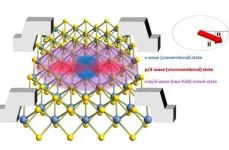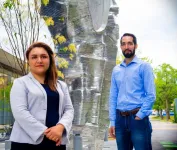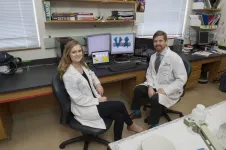(Press-News.org) New research published this week challenges a popular belief that intermittent fasting diets such as alternate day fasting or the '5:2' are the most effective ways to lose weight.
Over recent years, diets which see people fast on a few days each week have increased in popularity, reinforced by images of people's miraculous weight transformations, and backed by celebrity endorsements.
However, evidence to date about the effectiveness of fasting compared with more traditional diets which aim to reduce calorie intake over the course of a full week has been limited.
Published in the prestigious journal Science Translational Medicine, the new study from a team of physiologists at the University of Bath builds this evidence and indicates that there is 'nothing special' about fasting.
Participants in their randomised control trial lost less weight when fasting in comparison with those following a traditional diet - even when their calorie intake was the same overall.
The trial, organised by a team from the University's Centre for Nutrition, Exercise & Metabolism (CNEM), saw participants allocated into one of three groups:
Group 1 which fasted on alternate days with their fast day followed by a day of eating 50% more than usual.
Group 2 which reduced calories across all meals everyday by 25%.
Group 3 which fasted on alternate days (in the same way as Group 1) but followed their fast day with one day eating 100% more than usual.
Participants across all three groups were consuming a typical diet of around 2000-2500 kcal per day on average at the start of the study. Over the course of the three-week monitoring period, the two energy restricted groups reduced this to be between 1500-2000 kcal on average.
Whereas groups 1 and 2 reduced their calorie intake by the same amount in different ways, group 3's diet saw them fast without reducing overall calories.
Their results found that the non-fasting dieting group (Group 2) lost 1.9 kg in just three weeks, and DEXA body scans revealed this weight loss was almost entirely due to a reduction in body fat content.
By contrast, the first fasting group (Group 1) who experienced the same reduced calorie intake by fasting on alternate days and eating 50% more on non-fasting days, lost almost as much body weight (1.6 kg) but only half this weight loss was from reduced body fat with the remainder from muscle mass.
Group 3, who fasted but increased their energy intake by 100% on non-fasting days, did not need to draw on their body's fat stores for energy and therefore weight loss was negligible.
Professor James Betts, Director of the Centre for Nutrition, Exercise & Metabolism at the University of Bath who led the research explains: "Many people believe that diets based on fasting are especially effective for weight loss or that these diets have particular metabolic health benefits even if you don't lose weight.
"But intermittent fasting is no magic bullet and the findings of our experiment suggest that there is nothing special about fasting when compared with more traditional, standard diets people might follow.
"Most significantly, if you are following a fasting diet it is worth thinking about whether prolonged fasting periods is actually making it harder to maintain muscle mass and physical activity levels, which are known to be very important factors for long-term health."
These results focused on participants who were defined as 'lean' (i.e. body mass index 20-25 kg/m2). 36 people participated in the study which was conducted between 2018 - 2020 and funded by the University of Bath.
INFORMATION:
The full study 'A randomized controlled trial to isolate the effects of fasting and energy restriction on weight loss and metabolic health in lean adults' is published in Science Translational Medicine on Wednesday 16 June 1400 US Eastern Time; 1900 BST 10.1126/scitranslmed.abd8034.
PHILADELPHIA (June 16, 2021) - The current Medicare reimbursement policy for nurse practitioners (NPs) allows NPs to directly bill Medicare for services that they perform, but they are reimbursed at only 85% of the physician rate. A growing number of states are granting full practice authority to nurse practitioners. Even more states have loosened practice restrictions due to COVID-19. Both of these reasons illustrate why payment parity is essential.
In an article in The Online Journal of Issues in Nursing, Alycia Bischof, MSN, APRN, PNP-BC, Senior Lecturer at the ...
The long relationships between stars and the planets around them - including the Sun and the Earth - may be even more complex than previously thought. This is one conclusion of a new study involving thousands of stars using NASA's Chandra X-ray Observatory.
By conducting the largest survey ever of star-forming regions in X-rays, a team of researchers has helped outline the link between very powerful flares, or outbursts, from youthful stars, and the impact they could have on planets in orbit.
"Our work tells us how the Sun may have behaved and affected ...
An international team of physicists led by the University of Minnesota has discovered that a unique superconducting metal is more resilient when used as a very thin layer. The research is the first step toward a larger goal of understanding unconventional superconducting states in materials, which could possibly be used in quantum computing in the future.
The collaboration includes four faculty members in the University of Minnesota's School of Physics and Astronomy--Associate Professor Vlad Pribiag, Professor Rafael Fernandes, and Assistant Professors Fiona Burnell and Ke Wang--along with physicists ...
Clinical research on COVID-19 has boomed in the 18 months since the disease first appeared. Countless papers have looked at the topic from almost every possible angle, including methods of detection.
For a new paper published in the journal END ...
RIVERSIDE, Calif. -- Supermassive black holes, or SMBHs, are black holes with masses that are several million to billion times the mass of our sun. The Milky Way hosts an SMBH with mass a few million times the solar mass. Surprisingly, astrophysical observations show that SMBHs already existed when the universe was very young. For example, a billion solar mass black holes are found when the universe was just 6% of its current age, 13.7 billion years. How do these SMBHs in the early universe originate?
A team led by a theoretical physicist at the University of California, Riverside, has come up with an explanation: a massive seed black hole that the collapse of a dark matter halo could produce.
Dark matter halo is the halo of invisible matter ...
RESEARCH TRIANGLE PARK, N.C. -- A new approach to studying conjugated polymers made it possible for an Army-funded research team to measure, for the first time, the individual molecules' mechanical and kinetic properties during polymerization reaction. The insights gained could lead to more flexible and robust soft electronic materials, such as health monitors and soft robotics.
Conjugated polymers are essentially clusters of molecules strung along a backbone that can conduct electrons and absorb light. This makes them a perfect fit for creating soft optoelectronics, such as wearable electronic devices; however, as flexible as they are, these polymers are difficult to study in bulk because they aggregate ...
DALLAS (SMU) -- A team of SMU biological scientists has confirmed that P-glycoprotein (P-gp) has the ability to remove a toxin from the brain that is associated with Alzheimer's disease.
The finding could lead to new treatments for the disease that affects nearly 6 million Americans. It was that hope that motivated lead researchers James W. McCormick and Lauren Ammerman to pursue the research as SMU graduate students after they both lost a grandmother to the disease while at SMU.
In the Alzheimer's brain, abnormal levels of amyloid-β proteins clump together to form plaques that collect between neurons and can disrupt cell function. ...
Why can some people weather the stress of social isolation better than others, and what implications does this have for their health? New research from the Communication Neuroscience Lab at the Annenberg School for Communication at the University of Pennsylvania found that people who felt a strong sense of purpose in life were less lonely during the COVID-19 pandemic. Did they achieve less loneliness by flouting public health guidance? No. Although lonelier people were less likely to want to follow public health guidance, people with a stronger sense of purpose also expressed more willingness to engage in social distancing, hand washing, and other ...
A new study looking at the way human cells activate the immune system in response to SARS-CoV-2 infection could open the door to even more effective and powerful vaccines against the coronavirus and its rapidly emerging variants keeping the global pandemic smoldering.
Researchers from Boston University's National Emerging Infectious Diseases Laboratories (NEIDL) and the Broad Institute of MIT and Harvard say it's the first real look at exactly what types of "red flags" the human body uses to enlist the help of T cells--killers sent out by the immune system to destroy infected cells. Until now, COVID vaccines have been focused on activating a different type of immune cell, B cells, which are responsible for creating antibodies. Developing vaccines to activate ...
Steroid (sex) hormones play a central role in sexual development: They help determine how boys become boys and girls become girls. If these hormones are disrupted during fetal life, it can lead to a string of reproductive disorders at birth and later in life, including malformed genitals and decreased fertility.
Many environmental chemicals are known to disrupt the hormone system and are often referred to as endocrine disrupting chemicals. Azole fungicides constitute one group that can act as endocrine disruptors. Azoles are used to combat yeast infestations in seed and food crops, but are also used in medications for humans.
Most azoles used in medicines are tightly regulated and their use is well controlled. However, some are sold over-the-counter, for ...







